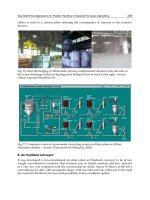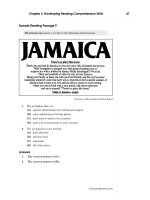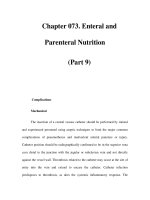Data Analysis and Presentation Skills Part 9 pps
Bạn đang xem bản rút gọn của tài liệu. Xem và tải ngay bản đầy đủ của tài liệu tại đây (474.02 KB, 19 trang )
Least significant difference (LSD) analysis
Using this test we are able to compare all of the differences
between mean values in our data set and determine what the
lowest value for the difference between any pair of means
would need to be for there to be significance at a given level.
The steps in the calculation of the LSD may be seen below.
Multiple range test – least significant
difference between means test
1. The ¢rst step is to calculate the standard error of the di¡erence
between any two group means from the formula:
s:e: ¼
p
fmean square within groups [(1=n) þ (1=n)]g (Equation 5: 3)
where the mean square (MS) within groups has been calculate d in the
analysis of variance and is shown in the ANOVA table under Sources of
Variation Within Groups, and n is the number of observations in each
group.
So for our example:
from the ANOVA table the mean square within samples
(groups)¼3.571 and n ¼5
therefore
s.e. ¼
p
f3.571[(1/5)+(1/5)]g
so this would be calculated in Excel from the formula:
¼SQRT(3.571
*
(1/5+1/5))
Having entered the formula into an active cell the value of1.195 should
be returned.
2. We now use the s.e. to ¢nd what the least di¡erence between means will
be for various levels of signi¢cance. From the ANOVA table the
degrees of freedom (df) associated with the mean square within
groups is 19 (calculated on the basis that the re were ¢ve observatio ns
in each group and fo ur treatments, so df ¼(564)71).
140 5 STATISTICAL ANALYSIS
Using the table of cri tical values for the Student t-test in the Appendix,
look up the 5 per cent and 1 per cent points of the t-distribution for 19
df.You should ¢nd that these are 2.093 and 2.861 respectively.
T he LSD is calculated by multiplying the s.e. by each value, therefore
the smallest di¡erence between means at the:
5 per cent level will be 2.5 (2.09361.195) and at the
1 per cent level will be 3.4 (2.86161.195 ).
In order to find out where significant differences are we must
take each set of means for each pH and subtract differences.
Using the facilities of the Excel spreadsheet it is easier to rank
mean values and then make pairwise contrasts as shown in
Figure 5.13. Using the LSD data we can determine where
significant differences exist between each pair of means. (In
order to report this fully, you may want to calculate the least
significant difference at a range of probability levels, 5, 1, 0.5,
0.1 per cent, as appropriate.)
We can now make some comparisons. For there to be a
difference in drug dissolution at the 5 per cent level of
significance there needs to be a minimum difference between
141ANALYSIS OF VARIANCE
Figure 5.13 One-way ANOVA and least signi¢cant di¡erence between means analysis
means of 2.5 and at the 1 per cent a difference of 3.4. From
these comparisons we can clearly see that there is a significant
difference in means which can be summarized as follows:
The drug dissolution at pH 2 is less than that at pH 5, 7 or 9.
The drug dissolution at pH 5 is less than that at pH 7 and 9 but
more that at pH 2.
The drug dissolution at pH 7 is less than that at pH 9 but more
than that at pH 2 and 5.
The conditions for drug dissolution are optimum at pH 9 as
dissolution is greater than at pH 2, 5 or 7.
(N.B. Unless there is found to be a significant difference in
treatments shown in the ANOVA, there is no justification in
then continuing and performing the LSD test.)
Two-way analysis of variance with replication
In the two-way ANOVA with replication we examine the e¡ects of two treat-
ments (factors) wi th replication in each treatment. For example, in the above
experiment we may have conducted our tests with two di¡erent formulations
of the drug, in which case we would be looking at both the e¡ect of the drug
formulation and the e¡ects of pH on drug di ssolution.We will work th rough
an exercise in which we will make comparisons of two factors using the two-
way ANOVA.
Exercise 5.7
In a Phase I clinical trial the pharmacokinetics of a new drug
was investigated in young and elderly subjects. An oral dose of
the drug was given as a single dose and blood specimens were
collected for 12 hours; dosage was then continued twice daily
for a period of two weeks after which the trial subjects attended
and blood samples were taken as before. The area under the
drug concentration time curve (AUC) was calculated for each
142 5 STATISTICAL ANALYSIS
subject for Days 1 and 15 of the trial. The data need to be
examined to determine whether:
. there was any significant difference in AUC for Day 1 and Day
15
. there was any significant difference in AUC between young
and elderly subjects
Before starting the statistical analysis we need to state the
hypotheses for the investigation. We are examining two factors
so we need to consider both of these when formulating the
hypotheses.
Null hypothesis: This will be a statement that there will not
be any significant differ ence in either of the two factors
investigated.
There is no difference in the AUC between Days 1 and 15 of the
study, or between young and elderly subjects.
Alternative hypothesis: There are two alternatives that can be
considered here, either one or both may be found to be true if
the test demonstrates a significant difference.
There is a significant difference in the AUC for the drug
comparing a single dose at Day 1 with a period of multiple
dosing on Day 15.
There is a difference in the AUC between young and el derly
subjects.
Enter the data in Figure 5.14 onto your worksheet, including
the labels as shown. The two-way ANOVA is accessed through
the Toolsjj Data Analysis menu. From the list provided highlight
Anova: Two-Factor With Replication. Enter the cell references
containing the data in the Input Range box, making sure that
you also include the labels. In the Rows per Sample box type 8
as there are data for eight subjects, both young and elderly, on
each study day. Set the level of significance,
a, to 0.05, then
click OK.
143ANALYSIS OF VARIANCE
The worksheet should now conta in the ANOVA table that wil l
show the Average values (and their associated variances) for
the young and elderly subjec ts on Da ys 1 and 15 of the study,
and the AUCs for young and elderly subjects combined. The
ANOVA table may be seen in Figure 5.15. This time, as
distinct from the one-way analysis, there are three probability
values.
The first, defined as Sample, is a value of 0.000 75 and
represents the between-rows analysis, i.e. the probability that
AUCs for young and elderly subjects are different. As the
probability is below 0.05 we can confirm that there is a
significant difference between AUCs and by comparing mean
values state that AUCs in the elderly subjects are higher, so it
would appear that elderly subjects handle the drug differently
from younger subjects.
The second probability value in the Columns row represents
the between-columns analysis for young and elderly subjects
combined, so that any difference between AUCs on Day 1 and
Day 15 may be determined. The value of 0.44 shows that there
is no significant difference between the two days, so the drug
would not appear to accumulate after two weeks’ dosing using
this regimen.
144 5 STATISTICAL ANALYSIS
Figure 5.14 Inputting data for the two-way ANOVA with replication
The final probability level is labelled Interaction and takes
into account both factors (age and multiple dosing). The
probability for Interaction can be used to determine whether
there is an interaction between the two variables, age and
multiple dosing, or if the effect of each variable is additive. The
P value of 0.07 would indicate that there is no significant
difference in AUC caused by the age of the subjects during
multiple dosing. If a significant interaction were found, this
might suggest a significant accumulation of the drug due to the
advanced age of the subjects and limit the use of the drug
owing to safety issues. As the value is close to 0.05 it might be
questionable as to whether the sample size was sufficiently
large to be certain that there was no effect. A fair amount of
variability is also evident in the data.
145ANALYSIS OF VARIANCE
Figure 5.15 Summary output for the two-way ANOVA with replication
Two-way analysis of variance without replication
T his test is also known as the ANOVA using a randomized block desi gn and
like the previous test examine s two factors within an exper iment. A block is a
set of data that has been grouped by the experimenter to allow very little
variation with in the block, before being randomized to particular treatments.
T here may be some variation between blocks due to various external factors,
but, as the data within the block is more consistent, grouping the data in this
way will help to minimize experimental error. As previously discussed, the
experimental plan should e nsure that a balanced design has been devised so
that bloc ks are comparable for the analysis.When an experiment is balanced we
can expect to apply the simplest stati stical analysis from which to state our
conclusions with clarity and without ambiguity.
Exercise 5.8
In an experiment to determine whethe r pretreating seeds by
refrigeration causes an increase in germination, seeds were
assigned to two treatments: control, where seeds were kept
under normal environmental conditions for 4 weeks before
planting, and cold-treated where seeds were kept for four
weeks at 48C. Seeds were sown in batches of 50 (equivalent to
blocks) over a period of 12 months. The growth of the plants
after 6 weeks was compared and the mean growth for each
batch calculated.
For each batch sown the environmental conditions will be
consistent; each batch represents a block. Between batches
there may have been some local variation in conditions, in
which case we must test the data not only for the difference in
treatments but for differences between blocks. The data may
be analysed using the two-way ANOVA without replication
that will determine whether there is a difference in the
germination of the plants and if this is influenced by external
factors.
The data is entered onto the worksheet as shown in Figure
5.16 Select ToolsjjData Analysis and from the dialogue box
highlight Anova: Two-Factor Without Replication and click OK.
146 5 STATISTICAL ANALYSIS
In the Input Range box type in the cell references for your data
(including the labels and column giving the batch numbers).
Check the Labels box to indicate that you have done this. Click
on OK. The ANOVA table should now appear on your worksheet
as shown in Figure 5.17. There are two probability values, one
showing the probability of a difference between rows, the other
the prob ablity of a difference between columns (but unlike the
two-way analysis with replication there is no interaction
between rows and columns).
The analysis for the growth data demonstrates the following:
. differences between batches/blocks (rows P= 0.000 000 26),
therefore there is a difference in the rate of germination of
the plants in the different time periods that the seeds were
sown, most likely due to seasonal changes affecting growth.
. no difference between treatments (columns, P¼0.76),
therefore there is no difference in the growth of the plants
depending on the prior treatment of the seeds before
sowing.
147ANALYSIS OF VARIANCE
Figure 5.16 Data for the two-way ANOVA witho ut replication
5.4 The Chi-squared (v
2
) test
In the previous sec tions we have looked at data where we were examining
di¡erences between means or medians. In this section we will explore the use
of the Chi-squared test that is used whe n d ata from one or more samples has
been placed into categories, i.e. the data are nominal. Data can vary in
complexity according to the observations taken in an investigation and so the
way in which it is appli ed is adapted for each situation.
Basis of the test
In the Chi-squared test we usual ly want to know if there is a di¡erence
betwee n observations that have been recorded and sorted into di¡erent
categories. As with any other statistical test we formulate a null and an alter-
native hypothesis. In the Chi-squared test we are interested in ¢nding whether
the frequency of our observations is in line with what we expected (re£ected in
148 5 STATISTICAL ANALYSIS
Figure 5.17 Summary output for the two-way ANOVA without replication
a statement of the null hypothesis, that there will not be any di¡erence in
observed and expected frequencies ), or whether a di¡erent pattern has
emerged during the investigation (re£ected in the statement for the alternative
hypothesis that there will be a di¡erence in observed and expe cted
frequ encies). The test is two-tailed as we do not specify in which direction we
would expect any change i n frequen cies to occur.
T here are a few cond itions to the use of the Chi-squared test:
1. Only freque ncy data can b e compared usi ng the test, not percentages or
proportions as these do not take i nto account the size of the sample. Sample
size has a direct bearing on the outcome of a test, as in any other type of
statistical analysis. Once the test has been performed we can then make
comparis ons on the relative frequ ency of events by conversion to percen-
tages or proportions.
2. The test may only be appli ed where expected frequencies are greater than 5
otherwise any resulting probability value would be invalid.
In the following exercises we will look at three di¡erent situations in which
the Chi-squared test is used.
Comparing categories in a single sample
This is the simplest situation in which we collect frequency data; obse rva-
tions are made with one sample from which two or more options may be
selected. The frequency data shown in Table 5.6 was obtained in an experi-
ment in which the preferences of a sample of students was ob served for two
di¡erent types of chocolate. The frequencies reporte d are the observed
frequencies and the data are organized into three categories. The purpos e of
the experiment was to investigate whether there was a preference by test
subjects for milk or dark chocolate or whether their selecti on was completely
random.
Null hypothesis: There is no di¡erence in the number of pieces of milk or dark
chocolate selected by the group of students.
Alternative hypothesis: There is a di¡erence in the number of pieces of milk or
dark chocolate selected by the group of students.
Level of Signi¢cance:5percent(P50.05).
149TH E CHI-SQUARED (w
2
) TEST
N.B.The Chi-squared test is always a two-tailed test, so this need no t be
quoted when performing the test.
Exercise 5.9
Enter the observed frequencies onto your Excel worksheet
from Table 5.6.
Use the AutoSum button to calculate the total number of
pieces of chocolate consumed.
Although the observed frequencies (number of pieces con-
sumed) is recorded in the experiment, we now need to
calculate the expected results, i.e. what results would we
expect if the selection of the chocolate was a comple tely
random process? If the process were random, we would expect
that it would be equally likely that the number of pieces of
chocolate consumed would be exactly the same (like tossing a
coin and choosing heads or tails), therefore the probability
should be 50:50.
The expected number of pieces eaten will equal
Total number of pieces/2
(as there are two types of chocolate).
On the Excel worksheet calculate the expected consumption
using the above relationship, i.e. enter the for-
mula ¼(205+289)/2. An answer of 247 should be returned. If
the selection of the chocolate pieces was completely random
we would expect that exactly 247 pieces of both dark and milk
chocolate would be eaten. We now have to test this against the
observed results to find out whether our observations are
significantly different from what we expected. Create a second
column in the table and enter the expected results as shown in
Table 5.7. We are now ready to perform the test.
Click on a cell in the worksheet where you want the result of
the test to be reported. The value that is returned is the
150 CHAPTER 5 STATISTICAL ANALYSIS
probability value only. From the Paste Function menu select
CHITEST from the Statistical options. Enter the cell references
for the Actual (observe d) range, and then for the expected
range and confirm your choices. The Chi-squared value of
P ¼0.000 157 is added to your worksheet. This is less than the
set significance level of 5 per cent. We therefore reject the null
hypothesis and accept the alternative hypothesis: the selection
of the chocolate is not a random process, the test subjects
show a pref erence for milk chocolate.
Goodness of fit test – data from a genetics
experiment
Genetics experiments are primarily concerned with predict ing the phenotype
of various crosse s with di¡erent genotypes.The Chi-squared test is invaluable
for determining whether the outcome of a breeding experiment is in ke eping
with predi cted Mendelian ratios. Mendel gai ned his reputation for cross-
breeding experim ents with peas. Some crosses involved the inheritance of
more than one characteristic.We will now work through an example where in a
cross-breeding experiment with pea plants, plants with round yellow peas
were crossed with plants producing wrinkled green peas. The ¢rst generation
(F1) plants from the cross all had round yellow seeds, indicating that the
151TH E CHI-SQUARED (w
2
) TEST
Table 5.6 Preferen ce for milk or dark chocolate shown by a test group of subjects
Type of chocolate Number of pieces consumed by test subjects
Dark chocolate 205
Milk chocolate 289
Table 5.7 Selection of dark or milk chocolate by a group of students
Type of chocolate Number of pieces
consumed by test subjects
Expected consumption
of chocolate pieces
Dark chocolate 205 247
Milk chocolate 289 247
o¡spring were all heterozygous, having alleles for both sets of charac teristics,
but with round and yellow alleles b eing dominant.The F1 gene ration were then
self-fertilized and in the resulting o¡spring the following characteristi cs were
observed :
Ty p e o f p e a
Observed
frequenc y
Round yellow 68
Round green 28
Wrinkled yellow 23
Wr i nk l e d g r e en 1 0
T he predicted Mendelian ratios for the experiment were:
Type of pea Expected ratio
Round yellow 9
Round green 3
Wrinkled yellow 3
Wr i nk l e d g r e en 1
In the se circumstances we will be applying the Chi-squared test to test the
goodness of ¢ t of the expected results to those observed in the experiment (for
this reason the Chi-squared test is sometimes referred to as the goodness of ¢t
test).
Exercise 5.10
Enter the observed data and expected ratio onto your work-
sheet as shown in Figure 5.18. Using the theoretical ratios, we
need to work out the expected frequencies for the different
types of peas in the experiment. Firstly we need to calculate
the total number of pea plants produced from the cross (use
the AutoSum feature for this calculation). This should give an
answer of 129. The total now needs to be split in the
proportions of 9:3:3:1 so the first calculation that needs to be
152 5 STATISTICAL ANALYSIS
made is to find out how many fractions of the total should
belong in each category. If we were having to share out a piece
of cake in these ratios we would know that we would have to
count up how many pieces of cake in total would be required,
so the answer to this is to add up the proportions, i.e.
9+3+3+1 ¼16.
The next step in to calculate what 1/16th of the total will
represent: i.e. 16 parts ¼129 peas, so 1 part ¼129/
16 ¼8.0625. (Calculate the answer using Excel.)
Once we have this value the observed frequency can be
calculated as:
Expected number of yellow smooth peas¼9 parts
(therefore 968.0625 peas)
The calculation is repeated for the remaining ratios until a
complete set of expected frequencies for all of the phenotypes
is produced on the worksheet. The Chi-squared test can now be
performed. Using the Paste Function, select CHITEST as before.
The probability value is entered onto your worksheet and
should be 0. 703. The results of the test shows that we can
accept the null hypothesis as there is no difference in the
153THE CHI-SQUARED (w
2
) TEST
Figure 5.18 Data for the Chi-squared test comparing Mendelian ratios
observed and expected frequencies of the pea plants. We can
therefore conclude that the observed frequencies were not
significantly different from those predicted by the Mendelian
model (we can therefore accept its validity for predicting the
genotype of the peas).
Comparing two samples
T his version of the Chi-squared test is used when we are comparing the
outcome of an experimen t involving two samples. It is applied to de termine
whether a particular treatment has any a¡ect on th e outcome of the experi-
ment, where one of our samples is often a control. This test has many
applications, particu larly where we are interested in ¢nding out whether a
treatment or event has had an e¡ect on a population from which samples are
taken for comparison.
Exercise 5.11
It is suspected that a component of a weedkiller spray has a
deleterious effect on the growth of a particular type of crop. An
experiment was set up in which 300 seeds were selected at
random and sown under identical conditions in three separate
plots with 100 seeds in each. One plot was sprayed with the
weedkiller, the second plot was sprayed with a special mixture
of the weedkiller in which the suspect component was not
added, and the third plot was sprayed with water. The seeds
were then raised under identical conditions and the number of
seeds that germinated after a period of 1 month were counted
in each plot. The results of the experiment can be seen in
Table 5.8.
In order to apply the Chi-squared test we must do as we have
in previous examples and calculate the expected frequencies
associated with the experiment.
Enter the data on your Excel worksheet as shown in Figure
5.19, including the blank table in which we will calculate the
expected frequencies.
154 5 STATISTICAL ANALYSIS
Firstly, determine the total number of seeds that germinated
and did not germinate using the AutoSum button. Using the
totals we can calculate the proportion (fraction) of seeds which
successfully germinated:
267 out of a possible 300 seeds germinated, so the proportion
will be 267/300 (use Excel’s formula bar to calculate the
proportion). The answer should be 0.89 and the prop ortion of
seeds not germinating will be:
33 out of a possible 300 so this will be 33/300. The answer
should be 0.11.
155TH E CHI-SQUARED (w
2
) TEST
Table 5.8 Comparison o f germination in water, special mixture weedkiller and full
weedkiller treated plots
Water treated
plot
Special mixture
treated plot
Weedkiller
treated plot
Germinated
successfully
87 91 89
Failed to germinate 13 9 11
Figure 5.19 Data tables for the C hi-squared test
The number of seeds expected to germinate/not germinate
now needs to be calculated for treated and control samples
(where 100 is the column total): for examp le,
the number of water treated seeds expected to
germinate ¼0.896100 ¼89
the number of weedkiller treated seeds expected to
germinate ¼0.896100 ¼89
the number of special mixture treated seeds expected to
germinate ¼0.89 6100 ¼89
(Note that the numbers are identical here as an equal number
of seeds was allocated to each treatment in the experiment;
this is not always the case.)
We now repeat the calculation for the seeds that are not
expected to germinate for each treatment:
the number of water treated seeds not expected to
germinate ¼0.116100 ¼11
the number of weedkiller treated seeds not expected to
germinate ¼0.116100 ¼11
the number of special mixture treated seeds not expected to
germinate ¼0.116100 ¼11
These values may now be inserted into the table for the
Expected frequencies. When this has been completed the Chi-
squared test can be performed.
Select a cell in which you want the probability value entered
and select CHITEST as in the previous examples. Ente r the cell
references for your observed and expected tables (but do not
include row and column totals).
The probability value for this experiment is 0.66. Clea rly
there is no difference in the numbers of seeds germinating
following treatment with the weedkiller with or without the
suspect ingredient and so we may conclude that it has no effect
upon germina tion.
156 5 STATISTICAL ANALYSIS
Yates’correction (continuity corre ction)
This is normally applied where there are 2 rows62 columns as the number of
degrees of freedom (df) for the te st becomes 1, or where values in cells of the
table are less than 5.The degrees of freedom are calculated from the number of
categories that are placed into columns or rows:
df ¼(nu mb e r of rows71)6(number of columns71) (Equation 5.4)
where the df ¼1 Yates’ correction is applied to provide a more conservative
value for the Chi-squared statistic and to prevent a Type I error from occurring
(refer back to section 5.3). There is no function in Excel to automatically
calculate Yates’ correct ion and produce a probability value, as in the previous
exercises. An example o f its use is provid ed o n the book’s support website as
calculations for Chi-squared with the correction must be made and then
compared with a critic al value from statistical tables.
WEB SUPPORT – SECTION 5
Plenty of examples will be supplied so that you will be able to practise
using the tests discussed in this section. Each will show how the solution
has been worked out using the Excel functions and will provide an
analysis and interpretation of th e results.
157THE CHI-SQUARED (w
2
) TEST









